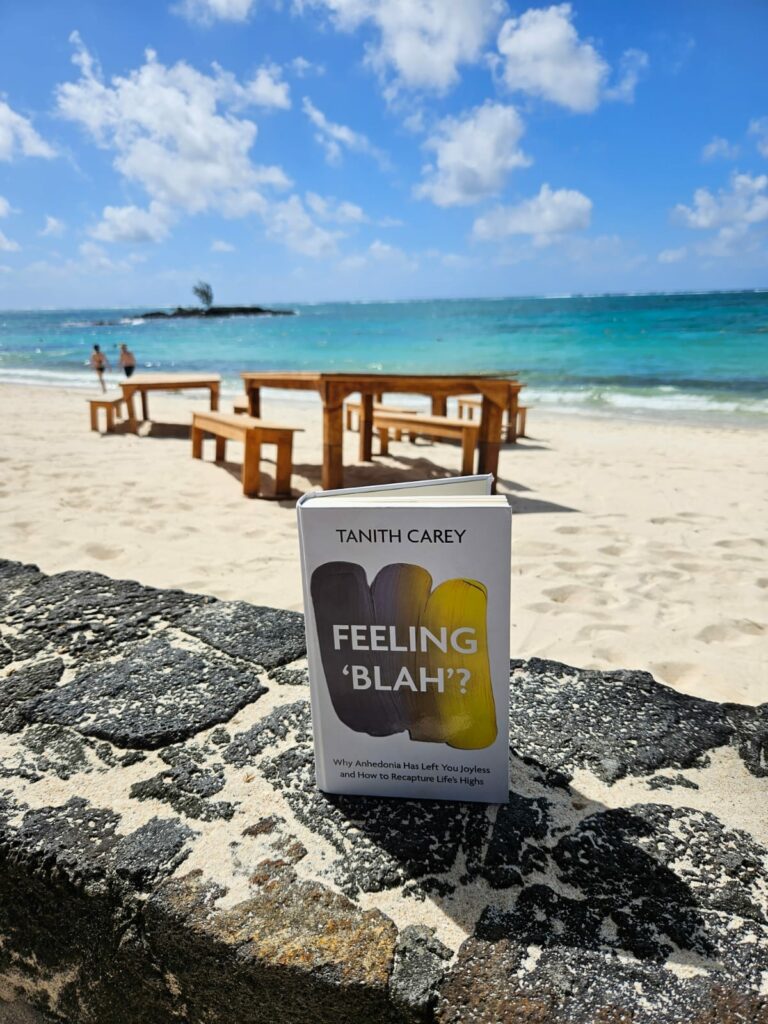
In the interest of full disclosure, I read ‘Feeling Blah’? by Tanith Carey, while on holiday. And with the sun on my body, and barely a thought in my head, I was feeling far from blah.
Nevertheless, blah is a feeling that I am somewhat familiar with, through my clients. It’s the feeling of numbness and detachment that leaves life depleted of colour and joy. It’s not depression, as such, but it is an enduring flatness and sense of floundering. It’s the knowledge that you’re trudging on with life, day after day, but without much pleasure or purpose
If you’re familiar with this state, then you probably already know its official name is anhedonia. And the author of Feeling ‘Blah’?, Tanith Carey, shares her own experience. She recalls a conversation, where her agent excitedly informed her that her book had been bought for a five figure sum, and she feels…nothing. Thus begins Tanith’s interest in anhedonia. She explores its likely causes, prevalence and potential cures.
Why we may feel numb or disconnected
As Carey explains, in her succinct and easy-to-read style, there are multiple reasons why we become numb and disconnected from life. Historically, the brain has been wired to cope with high levels of stress in short, sharp spurts. Imagine neanderthal man being chased by a tiger. The jolt of adrenaline that sends his heart racing and blood pumping, would hopefully get him safely back to his cave. In 2 minutes he’d either have fled, or be dead. But in modern life, the threat comes from demanding bosses, over stuffed diaries, and a sense of being on-call and over connected 24/7.
Looking at the research, Carey suggests that it’s this constant state of stress and adrenaline, that causes our brains to numb. And although this sounds pleasant in some ways – after all wouldn’t numb be better than scared, stressed or angry? It also deadens us to pleasant emotions such as joy, pleasure and happiness.

And because Carey is so thorough in collating the research on the topic she goes on to look at other potential causes of anhedonia. She highlights studies on the hormonal impact of menopause on women’s wellbeing. Looks at environmental factors that can zap our joy and also considers the link between blahness and post pandemic life.
All of this is important, because no one should live a life that is only bearable. We all deserve better than just getting by. And, as with most things in life, especially mental health, if left unchecked anhedonia can be a precursor to depression. Robbing us of our self confidence and self esteem.
Getting your groove back
Ultimately this is an important and useful book. Not only is it the first, of my knowledge, to explore anhedonia, but is also offers strategies to recover. Carey makes it clear that you can live a life with purpose and passion again. Recovery won’t necessarily be quick or easy, but it is possible, and achievable.
Her tips, all research based, include simple things such as walking in sunlight, getting a massage and learning to appreciate music again. Basically, find your feel good factor and make sure you incorporate it into your life.
My particular favourite piece of advice is to learn to lock in the happy moments. Appreciate you’re having them, and try to bank them in your memory to savour.
Many thanks to Welbeck Publishing for sending me a copy of this insightful and thought provoking book. If you want to share your own tips on beating the blah, then I would love to hear them
